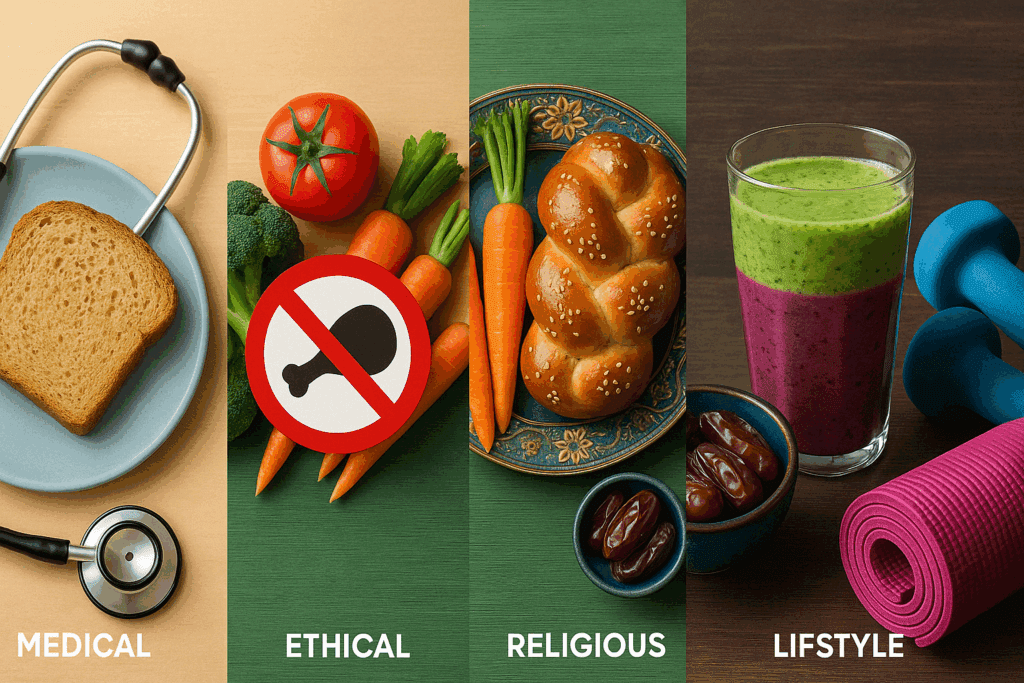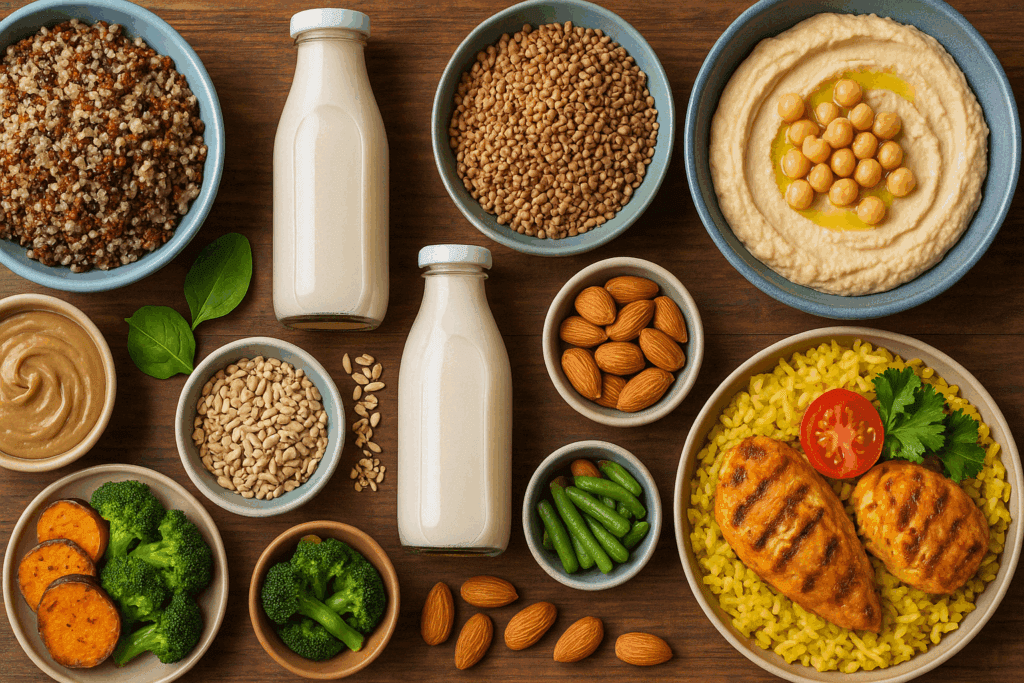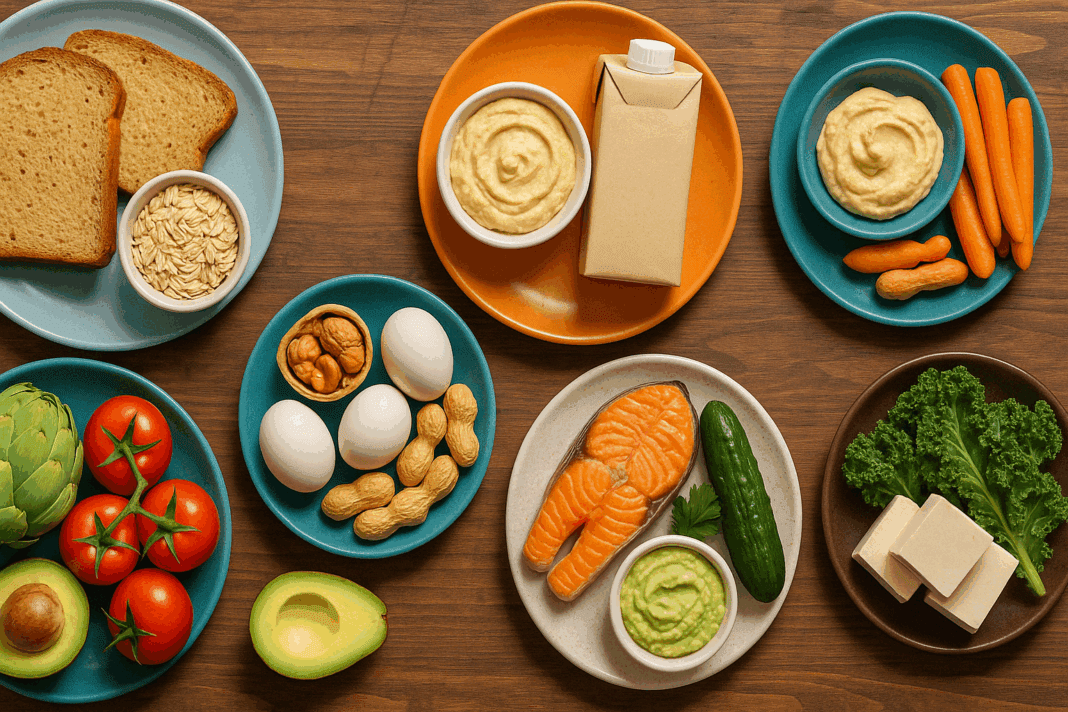In the ever-evolving landscape of modern health and nutrition, dietary restrictions have emerged as an integral concept, shaping the way individuals approach food, wellness, and lifestyle choices. Whether rooted in medical necessity, ethical beliefs, religious observance, or personal health goals, diet restrictions are increasingly influencing the foods we eat and how we relate to them. Understanding the types of dietary restrictions and how they interact with plant-based nutrition is essential for promoting both short-term well-being and long-term health.
You may also like: Plant Based Diet vs Standard American Diet: What the Latest Studies Reveal About Long-Term Health Outcomes
For those embracing a whole-food plant-based lifestyle, navigating food restrictions can be both empowering and challenging. This article explores the major categories of dietary restriction, their practical applications, and how individuals can maintain dietary requirements while ensuring a nutrient-dense, balanced diet rooted in plant-based health principles. Along the way, we will offer evidence-based guidance, examples, and insight into how thoughtful dietary planning can support vitality and longevity.
Defining Dietary Restrictions and Their Broader Meaning
To understand how dietary restrictions affect nutritional choices and long-term wellness, we must first examine the dietary restriction meaning in a comprehensive and contextual way. At its core, a dietary restriction refers to the deliberate limitation or avoidance of specific foods or food groups due to health conditions, religious practices, ethical considerations, allergies, or personal preferences. These limitations may be temporary or lifelong, voluntary or medically advised, and can vary in intensity and scope.
The dietary restrictions list encompasses a wide range of exclusions, including gluten, dairy, nuts, soy, animal products, and specific additives. For some, such restrictions stem from clinical diagnoses such as celiac disease, lactose intolerance, or food allergies. For others, they may reflect a commitment to plant-based or vegan living, which entails avoiding all animal-derived ingredients. Understanding these distinctions is crucial for creating inclusive, balanced diets that respect personal needs while promoting optimal health.
The meaning of dietary restriction extends beyond mere limitation; it signifies a purposeful approach to eating that seeks to align food intake with individual values, needs, or conditions. A clear grasp of this concept allows practitioners, nutritionists, and consumers alike to design meals that not only meet dietary requirements but also enhance overall quality of life.

Major Categories of Dietary Restriction: A Functional Overview
The major categories of dietary restriction can be broadly grouped into four core types: medical, ethical, religious, and lifestyle-based. Each type has distinct implications for food selection, nutrient availability, and dietary planning. Understanding these categories helps clarify the rationale behind common dietary restrictions and supports the development of flexible, health-conscious eating patterns.
Medical diet restrictions are typically mandated by healthcare providers in response to specific health concerns. These may include gluten-free diets for individuals with celiac disease, low-FODMAP diets for those with irritable bowel syndrome (IBS), or nut-free diets for individuals with severe allergies. The primary goal of these restrictions is to avoid triggering symptoms, inflammation, or adverse reactions, thereby preserving health and preventing complications.
Ethical dietary restrictions are grounded in moral or philosophical beliefs, often involving the rejection of animal exploitation and the promotion of environmental sustainability. Vegan and vegetarian diets fall within this category, focusing on plant-based nutrition and avoiding meat, dairy, eggs, and other animal products. These choices frequently align with a desire to reduce environmental impact and support animal welfare.
Religious restrictions are deeply rooted in spiritual practices and may involve complex guidelines around food preparation, consumption, and timing. Examples include kosher diets observed in Judaism, halal practices followed in Islam, and fasting rituals within Hinduism and Christianity. While these restrictions are faith-based, they often intersect with health and lifestyle considerations, especially when integrated into a plant-based framework.
Lifestyle-based restrictions are driven by personal preferences, wellness goals, or adherence to popular dietary trends. These may include low-carb diets, intermittent fasting, or sugar-free eating plans. Although not always medically necessary, such diet restrictions can influence nutrient intake, energy levels, and metabolic function. When aligned with plant-based principles, they require careful planning to ensure that dietary requirements are met.

Common Dietary Restrictions in Plant-Based Living
Plant-based nutrition naturally accommodates many common dietary restrictions, making it an appealing option for individuals with diverse health and wellness needs. However, it is important to understand how to modify or adapt plant-based diets to accommodate specific exclusions without compromising nutritional adequacy.
One of the most prevalent dietary restrictions in plant-based diets is the exclusion of gluten. Individuals with gluten intolerance or celiac disease must avoid wheat, barley, and rye, which are common in many vegan grain products. Fortunately, gluten-free grains such as quinoa, brown rice, millet, and buckwheat offer versatile alternatives that align with whole-food plant-based principles.
Dairy-free eating is inherent to vegan and plant-based lifestyles but may also be necessary for those with lactose intolerance or dairy allergies. In such cases, plant-based milk alternatives made from oats, almonds, or soy provide essential nutrients like calcium, vitamin D, and protein. Choosing fortified options can help ensure that these dietary requirements are consistently met.
Nut-free and soy-free diets are increasingly common, especially among individuals with allergies or sensitivities. These restrictions can pose challenges within plant-based eating patterns, as nuts and soy are often staple sources of protein and healthy fats. However, legumes, seeds (like sunflower or pumpkin), and whole grains can serve as excellent replacements, ensuring that the diet remains balanced and nutrient-rich.
Low-FODMAP diets, often recommended for managing IBS, involve limiting fermentable carbohydrates that can cause digestive discomfort. While many high-FODMAP foods are plant-based (such as garlic, onions, and certain legumes), thoughtful meal planning and ingredient substitutions can maintain adherence to both dietary restrictions and plant-based values.
These common dietary restrictions, when understood and properly managed, need not limit the benefits of plant-based nutrition. In fact, they can encourage greater creativity in the kitchen and a deeper awareness of the body’s unique needs, ultimately supporting long-term health outcomes.

Understanding Dietary Requirements Within Restricted Eating Patterns
When navigating types of dietary restrictions, it becomes essential to differentiate between food exclusions and the broader concept of dietary requirements. Dietary requirements refer to the intake levels of essential nutrients—such as vitamins, minerals, proteins, fats, and carbohydrates—needed to sustain health and prevent disease. Successfully adhering to diet restrictions while meeting these nutritional benchmarks requires intentional planning, especially within a plant-based framework.
Protein is a common area of concern for individuals following plant-based diets, particularly when additional restrictions such as nut-free or soy-free eating are in place. Nonetheless, a variety of plant-based protein sources, including lentils, chickpeas, hemp seeds, and whole grains, can collectively provide all essential amino acids when consumed throughout the day. The key lies in diversity and consistency.
Calcium and vitamin D are essential for bone health, yet individuals who avoid dairy may risk deficiencies. Fortified plant milks, leafy greens like kale and bok choy, and sun exposure or supplementation can effectively address these needs. Similarly, vitamin B12, naturally found in animal products, must be supplemented or obtained through fortified foods in vegan diets.
Iron is another critical nutrient that requires attention. While plant-based iron (non-heme) is less bioavailable than animal-derived forms, its absorption can be enhanced by pairing it with vitamin C-rich foods such as citrus fruits, tomatoes, and bell peppers. Monitoring intake and choosing iron-rich foods like lentils, tofu, and spinach can help maintain adequate levels.
Balancing fat intake is also essential, especially for those with dietary restrictions that exclude nuts or seeds. Avocados, olives, and flaxseed oil offer plant-based sources of healthy fats that support cardiovascular and brain health. Understanding and meeting these dietary requirements ensures that restrictive eating patterns remain both safe and sustainable over time.

Dietary Restrictions List: A Practical Guide to Plant-Based Substitutions
To assist individuals in managing food restrictions within a plant-based context, it is helpful to provide a comprehensive dietary restrictions list accompanied by practical substitutions. Doing so empowers individuals to maintain dietary variety, enjoy culinary satisfaction, and meet nutritional targets.
For gluten-free individuals, replacing wheat-based pasta with lentil or brown rice varieties, and opting for certified gluten-free oats, ensures both dietary compliance and nutritional diversity. Dairy-free eaters can explore a wide range of plant-based cheese and yogurt alternatives made from coconut, cashew, or oat bases. Fortified options are especially valuable for meeting calcium and vitamin D needs.
Nut-free eating may require careful label reading and substitution of nut-based spreads or snacks with seed alternatives such as sunflower seed butter or roasted pumpkin seeds. These substitutes are not only allergen-friendly but also rich in minerals like magnesium and zinc.
Soy-free diets can rely on legumes, quinoa, and peas as primary protein sources. Coconut aminos, a soy sauce alternative, can provide umami flavor without the allergen risk. Incorporating a variety of whole grains and vegetables helps ensure nutrient adequacy and culinary satisfaction.
This dietary restrictions list serves as a valuable resource for individuals navigating multiple limitations. By fostering creativity and awareness, it supports the development of balanced, inclusive plant-based meals tailored to diverse needs.
Dietary Restrictions Examples in Real Life and Clinical Contexts
Exploring dietary restrictions examples in both real-world and clinical contexts deepens our understanding of how restrictions function in daily life. These examples highlight the importance of individualized nutrition planning and the adaptability of plant-based eating in a wide range of scenarios.
Consider a patient with type 2 diabetes who also follows a vegetarian diet. Their dietary restrictions may include limited refined sugars, reduced saturated fats, and avoidance of meat. A plant-based nutrition plan tailored to these needs might emphasize whole grains, legumes, leafy greens, and heart-healthy oils to manage blood sugar while supporting cardiovascular health.
Another common scenario involves a child with multiple food allergies—such as dairy, eggs, and peanuts—requiring both medical supervision and strategic meal planning. Plant-based diets can be adapted to these needs by emphasizing safe legumes, non-dairy alternatives, and allergen-free baking techniques, ensuring adequate growth and development.
Individuals with chronic kidney disease often require diet restrictions that limit phosphorus, potassium, and sodium. While many plant foods are high in these minerals, portion control and food preparation methods (such as soaking and boiling) can make plant-based options viable with proper guidance from a registered dietitian.
Athletes who pursue plant-based lifestyles and avoid gluten or soy due to sensitivities can meet performance needs through targeted nutrient timing, protein blending, and the use of allergen-free supplements. These examples reinforce the principle that dietary restrictions need not impede health goals but rather necessitate a thoughtful and informed approach.
Embracing Plant-Based Health in the Face of Dietary Limitations
For many individuals, embracing plant-based health in the context of dietary limitations offers a transformative opportunity to align personal values with nutritional excellence. Rather than viewing restrictions as limitations, they can be reframed as pathways to greater intentionality, culinary exploration, and body awareness.
Plant-based eating naturally emphasizes nutrient-dense, anti-inflammatory foods that support immune function, metabolic balance, and chronic disease prevention. When dietary restrictions are incorporated with care and insight, they can amplify these benefits. For example, gluten-free whole grains and legumes support digestive health and glycemic control, while dairy-free alternatives reduce saturated fat intake and support cardiovascular wellness.
Importantly, the process of adapting to food restrictions fosters a deeper relationship with food, encouraging mindfulness, label reading, and home cooking. This awareness often leads to healthier patterns overall, as individuals become more engaged in the nutritional quality and sourcing of their meals.
Plant-based nutrition, when customized to accommodate food restrictions, demonstrates remarkable versatility and inclusivity. Whether managing allergies, chronic illness, or personal beliefs, individuals can experience the full spectrum of plant-based benefits while honoring their unique dietary profiles.

Frequently Asked Questions: Dietary Restrictions and Plant-Based Nutrition
What are some psychological effects of adhering to long-term dietary restrictions?
While dietary restrictions are often associated with physical health benefits, their long-term psychological impact is equally important. People who follow diet restrictions for extended periods may experience increased mindfulness and intentionality around eating, but they can also face social pressure, feelings of isolation, or food-related anxiety in unsupportive environments. This is particularly relevant when dietary requirements are rigid, such as with medically necessary food restrictions like celiac disease or multiple allergies. Developing coping strategies—such as learning to advocate for your needs at restaurants or social events—can greatly enhance well-being. Understanding the types of dietary restrictions you follow and preparing in advance can help balance mental health with nutritional goals.
Can dietary restrictions enhance metabolic health beyond weight control?
Yes, dietary restrictions can positively influence metabolic markers such as blood glucose, cholesterol levels, and inflammatory biomarkers. Individuals who adopt certain types of dietary restrictions—especially those based on whole, minimally processed plant foods—often report improved energy metabolism and reduced markers of insulin resistance. This is especially true when the dietary restrictions list eliminates common inflammatory triggers like refined sugars and saturated fats. Unlike calorie counting, these restrictions encourage nutrient-dense choices that support hormonal balance and long-term metabolic function. By aligning food intake with personalized dietary requirements, people can experience benefits that go far beyond simple weight loss.
How do dietary restrictions impact social and cultural food practices?
Navigating food restrictions in culturally significant settings—such as religious holidays or traditional family meals—requires sensitivity and preparation. Different types of dietary restrictions, including religious and ethical forms, often intersect with cultural customs, making it essential to find inclusive food alternatives. For instance, someone observing major categories of dietary restriction during Ramadan or Passover may seek plant-based recipes that honor tradition while complying with their personal dietary requirements. With growing awareness of dietary restriction meaning, more communities are embracing flexible, inclusive options that allow everyone to participate in shared meals. These adaptations reflect a broader societal shift toward cultural respect and food inclusivity.
Are there emerging technologies that help manage common dietary restrictions more easily?
Absolutely. Digital innovations are reshaping how people manage their dietary restrictions list, offering new levels of customization and support. Mobile apps now use barcode scanning and AI to detect allergens, suggest compliant recipes, or filter restaurant menus based on dietary requirements. Wearable tech is also entering the scene, helping users monitor their nutritional intake against specific food restrictions in real time. These tools can be especially valuable for managing overlapping diet restrictions—such as veganism combined with gluten intolerance or a nut allergy. As personalized nutrition technology advances, it is becoming easier to follow even the most complex dietary restrictions without compromising variety or enjoyment.
What are the long-term nutritional risks of restrictive diets that eliminate major food groups?
When dietary restrictions remove entire food groups—such as dairy, grains, or legumes—there is a risk of missing essential nutrients unless careful planning is involved. The challenge is not the restriction itself but how it’s managed in practice. For example, cutting out grains without replacing them with nutrient-rich alternatives can lower fiber and B-vitamin intake. Plant-based eaters with additional food restrictions must remain vigilant about micronutrients like zinc, iodine, and omega-3s. Addressing these concerns requires understanding the dietary restriction meaning in the context of nutritional adequacy, not just food elimination. With professional guidance and whole-food substitutions, these diets can be nutritionally complete.
How can someone with multiple food restrictions still enjoy diverse, flavorful meals?
Diversity in flavor and texture is achievable even with extensive food restrictions. Understanding your personal dietary requirements enables you to explore global cuisines that naturally align with your needs. For example, Ethiopian lentil dishes are often gluten- and dairy-free, while Thai cuisine offers many soy-free, plant-based options using coconut milk and herbs. Building meals around the dietary restrictions list rather than in spite of it helps shift focus from limitation to exploration. Creative use of spices, cooking methods like roasting or fermenting, and trying new plant-based ingredients can dramatically expand your culinary repertoire.
What role do social support and community play in managing dietary restrictions successfully?
Support networks are essential for maintaining diet restrictions, especially when navigating major categories of dietary restriction that affect daily routines. Community support—whether through online groups, local meetups, or shared cooking sessions—can reduce feelings of isolation and provide practical tips. For those with rare or multiple food restrictions, connecting with others facing similar challenges fosters resilience and resource-sharing. Understanding how the types of dietary restrictions affect lifestyle can help friends and family become allies rather than obstacles. By building a support system around shared values and empathy, dietary requirements become more sustainable and less burdensome.
How do food restrictions influence children’s development, and what are best practices for parents?
When children have food restrictions—due to allergies, intolerances, or ethical choices—careful management is essential to ensure optimal growth and development. Parents should work closely with pediatric dietitians to create age-appropriate meal plans that fulfill all dietary requirements. Involving children in meal prep and educating them about the reasons behind their diet restrictions fosters autonomy and a healthy relationship with food. Socially, it’s important to equip children with strategies for explaining their food restrictions in inclusive ways to peers and educators. Highlighting dietary restrictions examples from other cultures or family traditions can help normalize their experience and build a positive food identity.
Can diet restrictions evolve over time, and how should individuals adapt?
Yes, dietary restrictions are often dynamic rather than fixed. Food sensitivities may resolve, ethical views can shift, and health conditions may require changes in dietary approach. Understanding the fluidity of dietary restriction meaning helps individuals adapt without feeling like they’re betraying their past choices. Regular check-ins with healthcare providers and nutritionists can ensure that evolving dietary requirements are still being met. Flexibility—paired with education and self-compassion—is key to managing these transitions in a sustainable and empowering way.
What are some overlooked types of dietary restrictions in public health planning?
Public health initiatives often focus on major categories of dietary restriction like gluten-free or vegan diets but may overlook less visible needs such as histamine intolerance, oral texture sensitivities, or culturally-specific food taboos. These nuanced diet restrictions require targeted education and inclusive menu planning in institutional settings like hospitals or schools. By expanding the dietary restrictions list to reflect a wider range of lived experiences, public health programs can become more equitable. It’s important to gather data on underrepresented dietary requirements to shape responsive policies. Recognizing these lesser-known dietary restrictions examples enhances inclusivity and ensures that more people can access nutritious, safe, and satisfying meals.

Conclusion: Navigating Types of Dietary Restrictions for Lasting Plant-Based Health
Understanding the types of dietary restrictions and how they intersect with plant-based nutrition is essential for cultivating sustainable, health-promoting eating habits. From the major categories of dietary restriction—medical, ethical, religious, and lifestyle—to the detailed considerations of nutrient intake and substitutions, this exploration highlights the nuanced and adaptive nature of plant-based health.
By recognizing the dietary restriction meaning in its broader context, we move beyond the idea of mere food avoidance and toward a more holistic view of nutrition. Through careful planning, informed decision-making, and the use of comprehensive dietary restrictions lists and examples, individuals can create nourishing, inclusive diets that respect both their needs and aspirations.
Plant-based living offers a flexible and scientifically supported foundation for health, especially when dietary requirements are honored through mindful choices and diverse food selections. Whether confronting common dietary restrictions or navigating complex medical conditions, individuals can thrive on plant-based diets that are thoughtfully tailored and deeply nourishing. As awareness of food restrictions continues to grow, so too does the opportunity to support long-term health through personalized, plant-centered eating.
Was this article helpful? Don’t let it stop with you. Share it right now with someone who needs to see it—whether it’s a friend, a colleague, or your whole network. And if staying ahead on this topic matters to you, subscribe to this publication for the most up-to-date information. You’ll get the latest insights delivered straight to you—no searching, no missing out.
Further Reading:
10 Dietary Restrictions All Event Planners Should Know About
Plant-based diets and long-term health: findings from the EPIC-Oxford study
Disclaimer
The information contained in this article is provided for general informational purposes only and is not intended to serve as medical, legal, or professional advice. While NewsHealthWatch strives to present accurate, up-to-date, and reliable content, no warranty or guarantee, expressed or implied, is made regarding the completeness, accuracy, or adequacy of the information provided. Readers are strongly advised to seek the guidance of a qualified healthcare provider or other relevant professionals before acting on any information contained in this article. NewsHealthWatch, its authors, editors, and contributors expressly disclaim any liability for any damages, losses, or consequences arising directly or indirectly from the use, interpretation, or reliance on any information presented herein. The views and opinions expressed in this article are those of the author(s) and do not necessarily reflect the official policies or positions of NewsHealthWatch.

